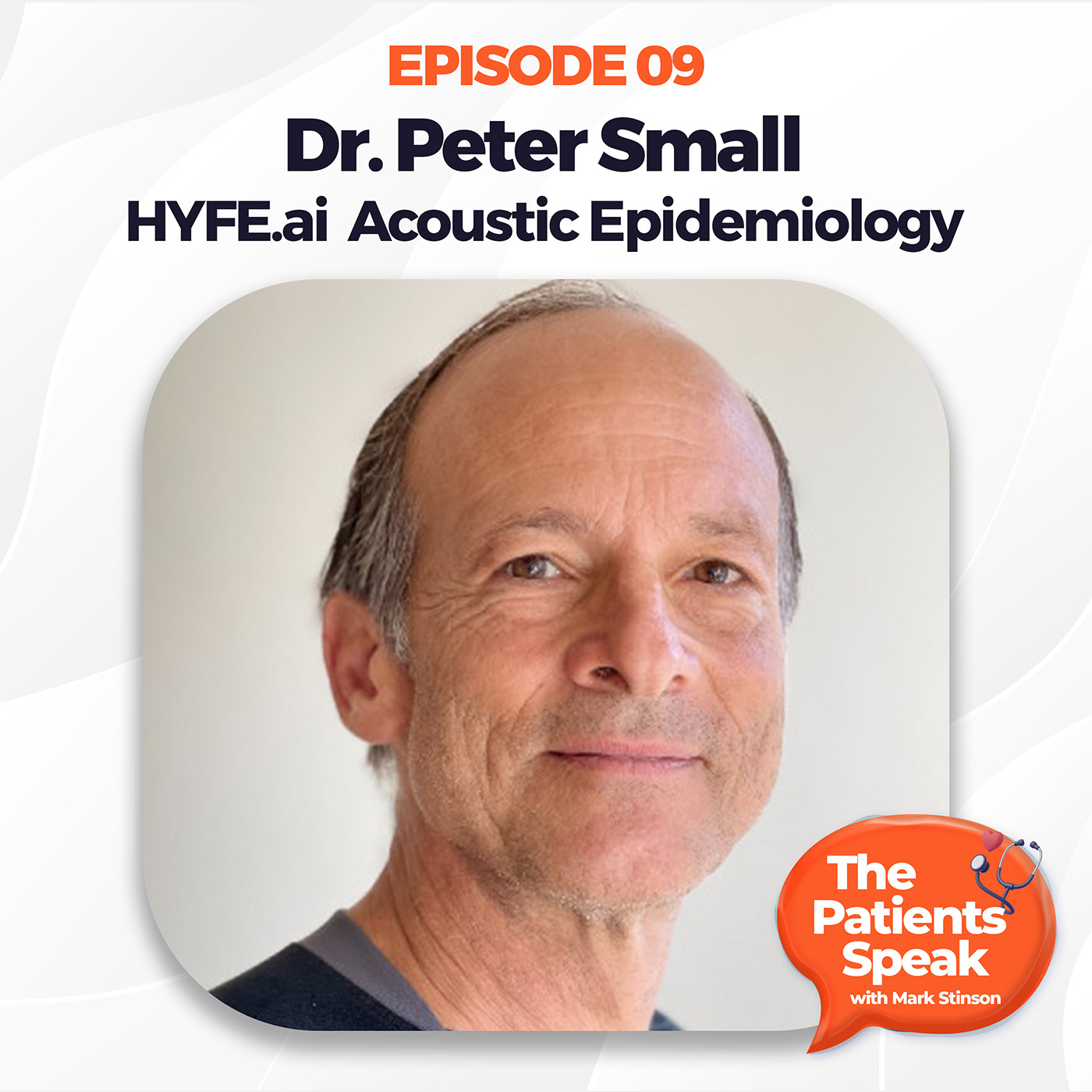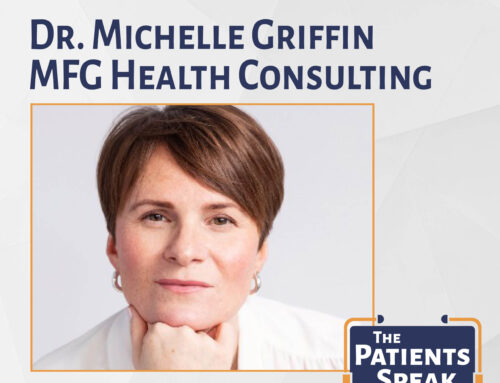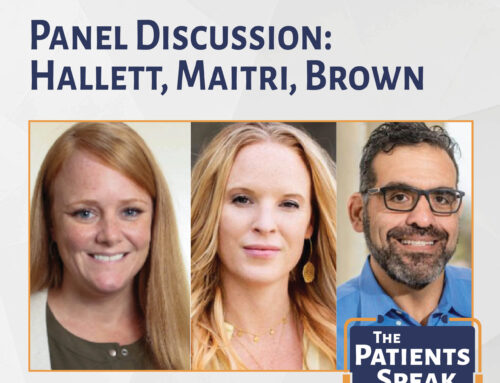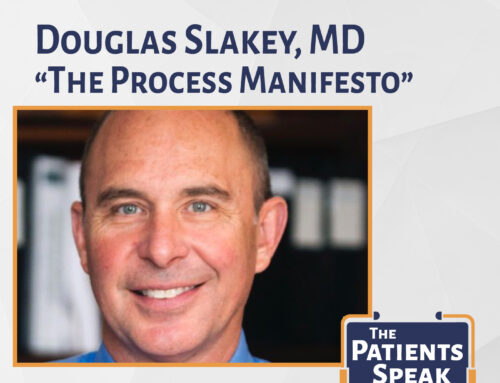Welcome back, friends, to our podcast, The Patients Speak. We’re the podcast where we try to capture both the business and scientific innovation that’s going on in healthcare with the patient’s voice and what we can learn when we really listen to the patient.
My guest today is Dr. Peter Small. He’s an acoustic epidemiologist by training and by trade, but he’s also leading the efforts to understand and quantify what cough can mean in a patient’s overall healthcare picture. His background includes global efforts in TB, he has also worked in international work with the Bill & Melinda Gates Foundation, with the Global Healthcare Initiative, and with other foundations and organizations in the area of lung and cough.
Mark Stinson, host:
Welcome back, friends, to our podcast, The Patients Speak. We’re the podcast where we try to capture both the business and scientific innovation that’s going on in healthcare with the patient’s voice and what we can learn when we really listen to the patient. My guest today is Dr. Peter Small. He’s an acoustic epidemiologist by training and by trade, but he’s also leading the efforts to understand and quantify what cough can mean in a patient’s overall healthcare picture. His background includes global efforts in TB, he has also worked in international work with the Bill & Melinda Gates Foundation, with the Global Healthcare Initiative, and with other foundations and organizations looking at worldwide, global, especially in the area of lung and cough. Dr. Small, it’s so good to have you with us. Thanks for coming aboard.
Dr. Peter Small, guest:
Thanks so much, Mark. It’s great to be here.
Mark Stinson, host:
Let’s start with this idea of cough in the patient’s journey and how they communicate that to the doctor, and then we’ll get into some of the innovations and things that you’re working on to help develop better diagnostics and better tools to measure cough. But what is it about cough that we need to understand, from the patient’s point of view?
Dr. Peter Small, guest:
I love speaking about this, because while my professional background is as a physician and a scientist and working in the field of philanthropy, I’m actually a patient, as well. I’ve had a refractory chronic cough for about three decades. I cough 40 to 80 times a day, so I’m well aware of this. I’m a little embarrassed to say that understanding the patient’s pathway to finding care for their cough is something that I came to understand relatively late in my professional career. Cough, it’s fascinating phenomena. On the one hand, it’s normal. If you never cough, you’ll probably die of aspiration pneumonia. On the other hand, it’s a symptom of disease. If you’re coughing a lot, you may be dying of aspiration pneumonia. So, it’s not like blood pressure, there’s no 120 over 80, there’s the amount of cough that’s good for your body.
That’s really where the issue of patients being able to understand and communicate with their providers is so broken right now, because the way that it transpires right now is you, if you are many people, and in fact, cough is one of the most common reasons that people seek healthcare, but if you have a problematic cough and you go to see your doctor, the doctor will say, “Well, how much are you coughing?” The honest response is, “I don’t know, Doc. How many times did you cough yesterday?” Because we really don’t know. And then they’ll say, “Well, what’s it sound like?” You’ll take this complicated sound and reduce it to a word like wet or dry. In fact, particularly annoying to have these conversations, and I’ve been on both sides of the bed on this conversation, it’s not at all gratifying for anyone, because you simply can’t accurately describe it, and therefore, it creates this confusion, which is particularly problematic in cough, because much of the diagnosis is made through therapeutic trials.
Mark Stinson, host:
Treating it and let’s see what happens. But you’re right, in the average primary care visit, blood pressure, blood sugar, all these other things, whether you have GERD, whether you’re dealing with anything, it often takes precedent over something that you think, well, I guess I cough a lot, but as long as we’re focused on my PSA, I’m not bringing up cough. So, where does it fit in the conversation and where do you think it should fit?
Dr. Peter Small, guest:
Well, for those of us who have problematic coughs, it should be at the top of the list, and yet, as you say, because it’s not easily measured, it’s often not addressed. That’s particularly ironic in this era of precision medicine where everything gets measured, that you go in and… Imagine if you were to go into your doctor and say, “I think I have a fever,” and the doctor were to say, “Really? How hot do you feel?” Hyfe is trying to do for cough what the thermometer did for fever. It made it real and quantifiable and actionable. From a patient’s perspective, it’s particularly problematic, because 30 years ago when I first developed a chronic cough, and I don’t remember the episode precisely, but I’m sure it went something like me going in and saying, “I’ve been coughing a lot,” and the doctor saying, “Well, it could be GERD or asthma, postnasal drip. Why don’t you take some Sudafed and let’s see how you do?” Which I really heard in a very dismissive way as, “Take some over the counter medicines and please don’t come back.”
Even if I had, I wouldn’t have been able to say, “Oh yeah, that drug reduced my cough by 30%, but I don’t think that’s far enough.” Instead, I’ve just learned to live with a cough, which was fine for many years, although it was embarrassing because I did TV research and every time I coughed, people would back away. But now, we all live in an era in which cough has been horribly stigmatized by COVID. I don’t have COVID, I know that, but when I cough in a grocery store, people back off like I just pulled an Uzi submachine gun out of my pocket.
Mark Stinson, host:
It’s quite disturbing. Well, maybe we turn the page, then, to the part of the story where we are working to quantify. You mentioned the company Hyfe that you’re affiliated with, maybe you can describe what efforts are being made to put some more specificity and more metrics around the cough.
Dr. Peter Small, guest:
So, we’re at a incredible time, I like to say the golden era of cough, because it’s become a very high profile symptom for patients. There’s a lot of interesting new science and new drugs that are coming along. We are surrounded by high fidelity microphones and mini computers in the form of cell phones and our smart watches, and so what Hyfe has done is we use acoustic artificial intelligence to be able to recognize the sound of a cough. We run in the background, so it’s privacy preserving, we don’t listen in, we just monitor levels. When there’s an explosive sound, we grab half a second and we run that through a computer algorithm that says whether it’s a cough or not.
This algorithm is super powerful. It’s been trained, we have now over 340 million cough sounds. We’re currently annotating a million of them a month to say they’re a cough or not, so we have this massive data set. It’s just like the Google Images, how does Google Image know what’s a cat and what’s a dog? It wasn’t like someone said, “Oh, pointed ears, a cat, floppy ears, a dog.” No, no. They just fed in a ton of pictures and the computer figures it out, and that’s what we’ve done with cough. So, we are really good now at running in the background on a smart watch or on a smartphone and giving people a readout of when and how much they’re coughing.
Mark Stinson, host:
What would be some of the clinical and practical applications of this?
Dr. Peter Small, guest:
Well, so first and foremost, I should say that this app, which is freely available for anyone, you can go to either the iOS or Android store and just download it for free, we’re finding it’s been very helpful for chronic coughers in terms of empowering them in their conversations with their providers. Again, as a chronic cougher, this happened to me just three months ago, when I did develop COVID and I called my health provider and they’re like, “Oh, you’re too young to be at risk, we’re not going to give you Paxlovid.” I said, “But I’m a cougher,” and they go, “Yeah, yeah, everyone coughs.” I said, “No, no, look at this,” and I showed them the app and I had coughed 400 times the day before, and they’re like, “Oh okay, here’s your prescription.” So, patients who have problematic cough, their lives can be ruined by it. There’s a very high level of depression. Women who have stress incontinence, when they cough, it’s super embarrassing, and so to be able to convey the magnitude of the problem to the provider is one incredible use that we’re finding.
I should say, we’re not yet an FDA cleared device, so what we’re really hoping people can do is to use this to inform them so that they can have smarter conversations, and for them to be able to, for example, realize that, “Wow, when I exercise on a cold day, I cough more, so I’m going to exercise inside today,” and for patients to take control of their own precipitators of their cough, change their lifestyle, and minimize their symptoms. Once we get FDA approved, then I think this will become just a standard part of care, the same way that temperature and blood pressure are routinely measured. And then the final thing is that we have a paucity of good drugs for cough. The last FDA-approved cough medicine was more than 60 years ago. One of the reasons is it’s very hard to do clinical trials when you can’t measure the endpoint. So, we’re hopeful that drug companies will start using this to accelerate the development of better technologies and drugs, as well as patients and providers using it to improve the quality of care.
Mark Stinson, host:
Yes. You mentioned this drug development, I think about recruitment and clinical trials, and certainly, the presenter… Well, as long we’re talking about cough, I’m having a fit now. But the presenters of this podcast, 83bar, are deeply involved in patient recruitment and identification of people who might want to be involved in drug development. Could you see this as a patient selection tool?
Dr. Peter Small, guest:
Absolutely. I mentioned that there’s been a lot of insights into the science of cough recently, which is leading to a handful of promising new drugs. Those trials, there was one trial where they did, and they recruited patients, they just tape-recorded people for a day and then they count the cough, and it took them a couple of weeks to do that. By the time they actually started and enrolled those patients in the trials, 15% of the patients didn’t even have a serious cough anymore.
So, the ability to know, passively and in real-time, how much people are coughing and to be able to find those patients and recruit them into your trials, I think this is something that contract research organizations who are smart are going to jump on very quickly, because cough, it’s just this so-called refractory chronic cough, cough is a prominent symptom of COPD and asthma and GERD and sinusitis. There are many drugs for which cough is an indication, and there are also other drugs for which cough is an adverse side effect, so the ACE inhibitors. So, if you want to make sure that your new ACE inhibitor isn’t causing a cough, it’s now possible to do.
Mark Stinson, host:
More than just maybe a patient diary, that you could actually measure it.
Dr. Peter Small, guest:
It’s interesting, because, in terms of Patients Speak, these patient-reported outcomes are really important perspectives when you’re doing an intervention or a clinical trial. You give somebody a new medicine and you ask them, “Do you feel like your cough is getting better?” And yet, that’s not the same as, “Is your cough actually decreasing?” I would never pit these against each other, but I see them as very complimentary. We are doing studies now, we have 50 patients for whom we ask them, every day, how’s their cough, and we’ve monitored them for weeks. It’s interesting how the trends align, but the details are super informative.
Mark Stinson, host:
Very interesting. Well, the company you’re referencing is called Hyfe. Listeners, if you want to read more about it’s H-Y-F-E.ai. Hyfe.ai, and Dr. Peter Small is the Chief Medical Officer there. Well, Dr. Small, I was also curious from the patient’s voice, even widening out from just cough, and all your other maybe experience here from Stanford to Stony Brook to Madagascar and Nepal, is there a time that you can recall where really being face-to-face and eye-to-eye with the patient and hearing something from them changed your perspective? You’ve done the clinical research, you did the large papers, spoke at the large conferences, but there was this encounter with the patient where their story really impacted you and maybe caused you to shift some thinking. Can you think of a time?
Dr. Peter Small, guest:
Well, absolutely. As I said at the top of the interview, I am sort of embarrassed how late that happened in my career. My background was in science and public health, and we looked at the massive problem of tuberculosis, which was killing 1.7 million people a year. I came at it from a scientific perspective of what’s the best drug combination and a public health perspective of how we reach the largest number of patients? It wasn’t until I moved my family to India for two years to work with the government there and spent thousands and thousands of kilometers driving around some of the most remote parts of India that my mind flipped to, it wasn’t the Minister of Health’s perspective that mattered, it was the patient’s pathway to cure. How was it that when a woman in a remote village started coughing, where did she go and what did she pay? The people who she saw, what did they do and how often did they get it right? How could you change the incentive such that everybody got to the right answer faster?
This so-called patient’s pathway to cure analysis, where that really was, for me, a game changer. It’s kind of embarrassing, because I think if I’d come into healthcare from a different perspective, I probably would’ve picked that up the first day. But it actually has been a quiet revolution in the field of tuberculosis away from the Minister’s perspective, towards the patient’s pathway perspective. I think what’s happening as a result is that some of these new tools are being implemented in a far more effective way. If patients are first seeking care from a local, unlicensed doctor in remote India, you’re not going to make progress by lecturing the doctors in the capital city.
How do you actually go out and look at the places, where was the delay? Where were the patients lost? Bringing all of that together to facilitate a prompt and comprehensive pathway that brings patients from first seeking care to empowering them. I think at the highest level, it’s this digital transformation of patient-centric passive data collection, and then giving the patients control over that information, so that it’s just made obvious to them how, for example, they’re coughing a lot and it’s usually in the late afternoons when they are cooking indoors in Madagascar or when they’re going for a jog on a cold day in Boston, and then they can take control of their health themselves.
Mark Stinson, host:
These are very personal insights. Thanks for sharing that story, first of all. And then let’s talk about where we are now, Dr. Small. I don’t think it has to be this technological Star Wars future to imagine that we could apply some of these digital tools to accelerate that patient journey. Certainly, you described this faster diagnosis, faster treatment, faster pathway to wellness, and that’s what everybody wants. How can not only the maybe Hyfe innovations, but other things that you’re seeing, how could this accelerate that patient journey?
Dr. Peter Small, guest:
Well, I’ll start by saying that COVID was an unmitigated disaster, but it had this thin, little, silver lining, and that is it has facilitated transformational change at a pace that was unprecedented in the history of medicine, which is traditionally, a very conservative and slow to change, for obvious reasons. I think what’s really interesting, to me, is the central role that the patients themselves can play in selecting those innovations that make a difference. We have more than 30 studies going on around the world to try and understand whether having cough information actually makes a difference. Where it makes a difference, we’re going to double down, and where it doesn’t, we’re going to back off. But it’s actually, at the end of the day, the users who will say, “Oh, that’s helpful to me,” and keep referring to it, keep it running on their phone.
And then the second is, I think it’s also the patient taking the information, whatever information they’re acquiring, and bringing it to their doctor and insisting that their doctor look at it. Because I know, as a physician, super busy, very limited time, someone pulls out some new information, you’re like, “Oh Jesus, this is the last thing I need is more data,” but the patients know and they know what data the doctor should be aware of. I think it’s going to require a push from the patient side for a lot of this kind of information to start to be incorporated in medical decision-making.
Mark Stinson, host:
Well, certainly, we need to tune into that patient voice. Well, Dr. Small, taking all of our conversation and maybe taking a little 50,000 foot view, but also a call to action to listeners who might be either from the Main Street clinic all the way to big pharma or biotech or diagnostic companies, even investors in medical companies, what do we need to hear and what do we need to really tune our antennas in to hear from the patient, in your view?
Dr. Peter Small, guest:
So, I’m going to limit my comments to cough, because as you can tell, that’s my current obsession. Look, we are in what some people would call a zero to one field. This is never been done before. It has never been possible to passively and unobtrusively someone to monitor their own cough and see the patterns and the magnitude of that. It is not unlike Uber as the first company to have regular people driving taxis, basically. With that comes this huge challenge of adoption, because it requires an imagination. I can’t tell you how many doctors I’ve talked to are like, “Well, I don’t really need that. If a patient’s coughing, they’ll tell me.” It’s just mind-blowing to me, as somebody with a chronic cough, how hard it is to change the minds of patients, providers, and health systems, even when they’re faced with transformational new information.
Mark Stinson, host:
And yet here they would have it, in their hand.
Dr. Peter Small, guest:
I think that they just need to push, they need to push it. They need to push the conversations.
Mark Stinson, host:
Well, what a terrific conversation, Dr. Small, I can’t thank you enough for coming on. Listeners, my guest has been Dr. Peter Small, his company is Hyfe. H-Y-F-E.ai. You can find him on LinkedIn at Peter M. Small. Dr. Small, thanks again for the conversation.
Dr. Peter Small, guest:
Thank you so much, Mark.
Mark Stinson, host:
Yes, and thank 83bar for sponsoring and presenting this conversation all in the name of accelerating the patient journey from diagnosis to wellness? How can we get there faster and how can the exchange and the interaction and the empowerment of the patient help make a difference? Come along again, for our next interview, we’ll talk to another innovative healthcare executive about what we can learn when we listen to The Patients Speak. I’m Mark Stinson, we’ll see you again soon.





